Pump organs are extraordinary contraptions of artistry, from their build style to their intricate patterns and designs to the unique mechanism to make sounds. And the best part is these contractions are timeless, making them the perfect investment in the antique market. However, despite that fact, you still can’t prematurely claim any Pump Organ you find to be the best investment. Some may have a Value too low to invest in the antique market. So You’ll have to gather more information about the pump organ you’ve found.
Because its value, like most antique pieces, is determined by certain factors. Such as its brand, age, style, features, and concepts like rarity and others.
Please read on as we delve into the valuation of antique Pump organs. We discuss different aspects of it. Like its history to help understand the progress of the pump organ’s design since its invention in the late 1800s. And how to identify them based on factors like their style and brand.
Table of Contents
The History of Antique Pump Organ
The Reed pump organ or harmonium or melodeon was invented on August 9, 1940, by a French inventor known as Alexandre Debian. This particular Organ offers better convenience than the pipe organ ever did in terms of portability, maneuverability with sound’s baseline, and easy maintenance.
Its mechanism works cleverly, as the Reed pump organ uses a pressure system, which involves passing air via two pedals through the vibrating metal part of the Organ connected to the keys, known as the Reed. This mechanism causes Reed to make a distinct sound that is different for all keys.
Such organs were famous in the leading countries of Europe. However, during the late 1800s, America invented its own portable free Reed organ. It’s the type that uses a suction system to create the sounds of the keys instead of a pressure system like the Reed organs from Europe.
Users of both types of reed organs notice the difference in the sound quality of both organs. The reed organs that use a pressure system tend to offer a better quality of loudness. On the other hand, Reed organs using the suction system provide lower sound intensity. These facts are why your American-style organs are usually found in old abandoned houses or taken from there. It’s also why the pump organs using the pressure systems are typically present in noisy places like a church or a bar.
By the 1900s, manual Pump organs became very popular as almost every home would have one (usually in their sitting rooms). Further down the century, companies pay famous composers like Alain, Karg-Elert, Widor, and others to write songs for their products. Also, clever features such as the one-note chord became part of the design. This feature enables inexperienced users to learn as the keys stay down to track how you play.
Later on, during World War 2, an electric-powered organ was invented. It led to the slow dismissal of the pump organ among customers due to the electric-powered versions being the far more convenient alternative.
Today the market for the forgotten antique reed Pump organs returns, as there many collectors that place a lot of value in them.
How To Identify Antique Pump Organ
Here are several ways to identify your antique Pump Organs age and value:
Maker’s mark
You can find your pump organ’s mark or signature within the cabinet. A sticker, tag, or stenciled print should be visible immediately. You should use a flashlight if possible, as the cabinet space could be void of light. You can also find the name of the brand above the keyboard. However, there’s a chance the name around there isn’t the distributor for the manufacturers. The only possible case where it’s the manufacturer’s name on the above keyboard is if the manufacturer happens to be the distributor. Sometimes that space might even be empty.
Serial Number
Apart from the brand, you can also identify your antique Pump Organ from its serial number. The best you can get out of such a clue is the age of the pump organ, and thus its possible pricing. How do you find it? You can find the serial number of your pump organ on the back paneling or the framework. There should be at least 5 (up to six) numbers stamped or stenciled on the Organ.
Given that the number of pump organs with serial numbers was 521,000 from 1850 to 1910, each unit represents a position made from first to the 521,000th unit. You can trace the position of your pump organ if its serial falls within the set of manufactured units from specific periods from the late 1800s to 1950.
| Serial Numbers (number of units released) | Year |
| 8700 | 1864 |
| 8700 – 100,000 | 1880 |
| 100,000 – 250,000 | 1892 |
| 250,000 – 350,000 | 1905 |
| 350,000 – 500,000 | 1950 |
Note: if you find a four-digit number, it is a construction number.
The keys
You can also identify the age of your antique Pump organs from the material of its keytops. So, if you notice that they happen to be ivory keytops, it’s mainly like a unit made before the 1960s. However, there are cases where plastic or celluloid keys are the material of the keytops. And they are known to exist in the late 1800s (1880s).
Note: the plastic of an original variant. None like the adulterated ones made in the 1900s.
Identifying Pump Organ for Its Wood Material
The type of wood material of your pump organ can also help in identifying the value of your antique Pump Organ. For instance, the most common type of pump organ wood you’ll like in an auction, antique store, or online store are oak and walnut. These units of pump organs were the ones sold cheaply. During the late 1800s was made of veneer or rosewood veneer, to be specific.
Identifying Antique Pump Organs from Their Functions
From around the time of its invention, the pump organ strictly produces piano sounds via a pressure system or suction system that works from the pump action of the two pedals below or a crank system. Later on, companies looking to beat their competitors added several features. Such as a baseline control system that allows you to determine the quality of sound or setting your keys should be. You can access this feature by pulling dials above the keys or via extra pedals.
Also, companies resorted to building beginner-friendly features on their pump organs. Features like the note a chord or the one-finger chord.
Popular Manufacturers Antique Pump Organ
Here’s a list of all the popular Manufacturers of antique Pump organs:
- J.Estey & Co
- Beckwith
- Western Cottage Organ Co.
- Packard Bros.
- Prince & Co.
- Mason & Hamlin.
- Williams Organ Company
- Story & Clark Organ Co.
Assessing Antique Pump Organ Value
Now that you can identify your antique Pump Organ, here are several methods to assess its value:
Condition
For antique Pump organs to cost tens or even hundreds of thousands of dollars, it has to be in mint condition. With minimal or no damage. Although, this may not be entirely realistic as the oldest pump organ is bound to have some issues such as cracks, rusty parts, termite infestation, or even discoloration. Thankfully, some collectors consider restored pieces to have the same value as pieces in mint condition. So paying for them will most likely be an issue.
So, let’s assume you have an antique Victorian Pump Organ in hand. Its value could be within hundreds of dollars or a few thousand. However, if it’s in mint condition, it could be sold for up to $10,000.
Note: sometimes, antique organs can still be valuable to collectors despite the damage.
Rarity
Another way to assess the value of your Pump Organ is to rate its rarity; for you to do that, you have to find out specific facts about it. Such as, how many of its styles or design out of the above 500,000 units created are in circulation? For instance, pump organs made of oak or walnut are pretty standard. But any Pump Organ made of veneer or veneer rose would be rare. Such pump organs would be costly in the antique market.
Another form of rarity you can notice is through Provenance. Because the pump organ’s price can skyrocket as it could be previously in possession of famous composers or prominent persons, the Organ’s Provenance value can also stem from its location. Such as a renowned bar, hotel, and so on. However, there has to be proof.
Age
You can assess the value of your pump organ from its age, as the older units tend to attract a heavier price than newer ones. You have to identify its age from several clues, such as the serial numbers and the maker’s marker. If they both happen to be absent, you can observe other favors like their mechanism for working, style, function, and physical qualities, which you can use to compare with various kinds of pump organs made during a particular period in history.
Mechanism
If the pump organ’s mechanism is crude, its value is bound to go high. For instance, if your antique Pump Organ possesses a crank system or a pedal pressure system that produces sound, it will cost more than a modern electric organ.
Style
Pump organs consist of excellent features, such as a fine quality wooden cabinet and intricate patterns. All of which can make the room or immediate environment much more appealing. Especially if the pump organ is Victorian, families tend to keep them in their sitting rooms. So, collectors could be buying antique Pump Organ bars of beauty instead of age or rarity.
Research
You play your part by performing rigorous research on your antique Pump Organ. An excellent way to start is to identify the antique piece first. Does it have a maker’s mark? Does it have serial numbers? How old is the unit? All answers to those questions about your pump organ should be compared online with organs from appraiser sites, primarily specializing in antique Pump Organ units.
Another way to perform your research is to visit forums and ask about your antique Pump Organ. Your Fellow collector could have some vital information about your findings. Or better yet, you could visit forums from appraiser sites.
Compare to Recently-Sold
Another way to assess the value of your pump organ is by comparing it with other recently sold units.
Here are comparable examples:
- A small harmonium portable mini “melodeon”, “reed organ” or hand “pump organ” is sold for $400 in 2022.
- An extremely rare INA leg harmonium 1960’s Vintage Ornate Portable Folding Foot Pump Organ in top notch condition is sold for up to $10,000 in 2021.
A Cottage Treasure pump organ from the 1800s is sold for $1,100 in 2022.
Hire an Appraiser
If you’ve performed your research but can’t discover anything tangible about your piece, the next best solution is hiring an appraiser. They will assess the value of your pump organ based on the list of factors they have prepared, along with recently sold pieces.
Top 5 Antique Pump Organ To Buy This 2022
5. Estey Antique Victorian Parlor Pump Organ
It is a fully restored oak pump organ with a large, well-designed cabinet. You can also notice its impressive style on the pedals, covered with a red carpet. And the sides of the pump organ have wooden geometric patterns. The Markings above the keyboard say its manufacturer is Estey Organ Co.
Overall, this type of pump organ would go well with your sitting room setting.
Price$(300)
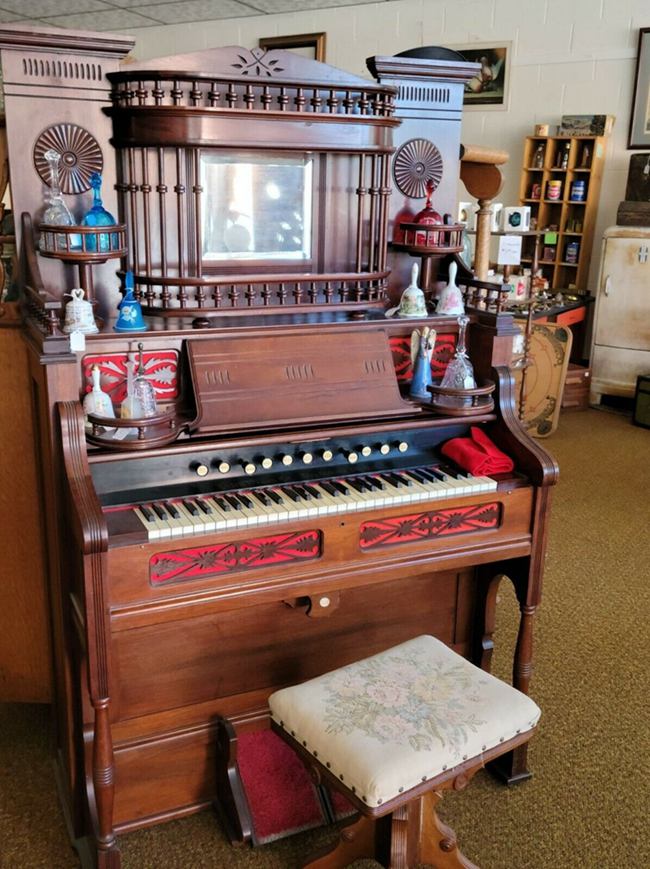
4. Cornish Foot Pump Organ
Here’s an organ that the Cornish pump organ company manufactured as it’s one of the 8000 units released from 1879 down to 1917. Despite being that old, the pump does look to be in mint condition with minimal damage to the paneling. However, the keys, pedals, and lever stops are perfect for continuous use.
Note: an electric organ comes with this unit.
Price$(200)
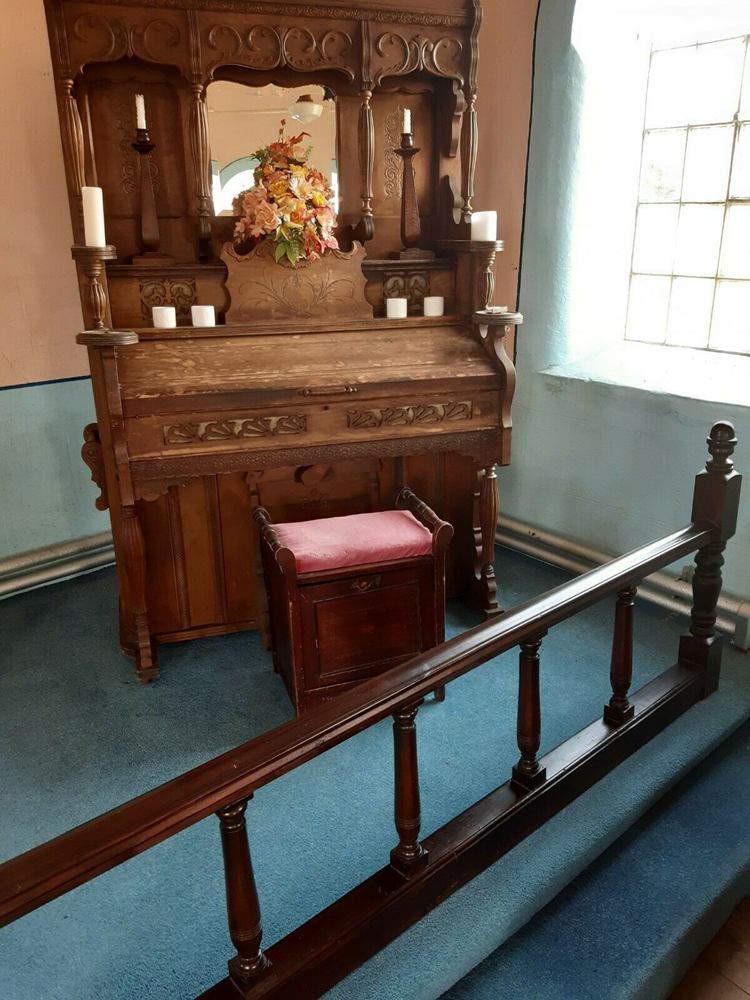
3. Beautiful Antique Adler Pump Organ Elaborate High Back Walnut FREE SHIPPING
It is a beautifully designed Walnut wooden pump organ covered in intricate floral patterns on the sides and pedals. The cabinet is massive. It would offer more style to your room. Also, the label within the cabinet says it’s from the company Adler. Overall, the unit is in excellent condition.
Price$(1300)
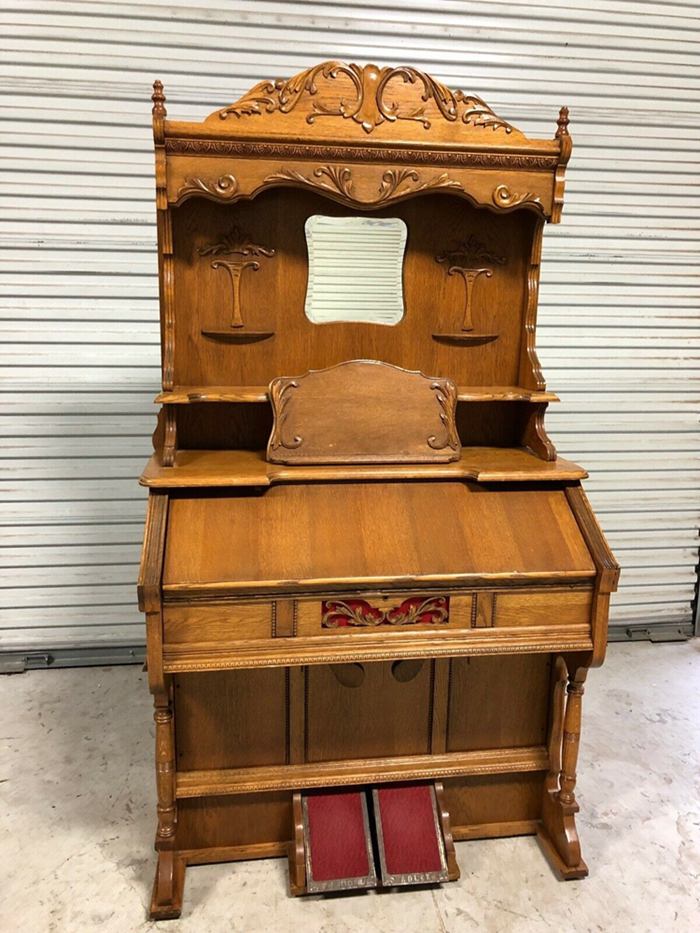
2. Antique Organ from the Chicago organ Co. sole Agent R. Muller. Cape Town
Here’s a Chicago cottage pump organ made out of veneer wood. Its cabinet structure imitates a castle’s architecture with a mirror window. Such a design would go great with your Parlor or a church setting.
The keys and lever stops are in excellent condition. Also, the pump-to sound mechanisms are fluid, and they provide quality sounds.
Price$(1200)
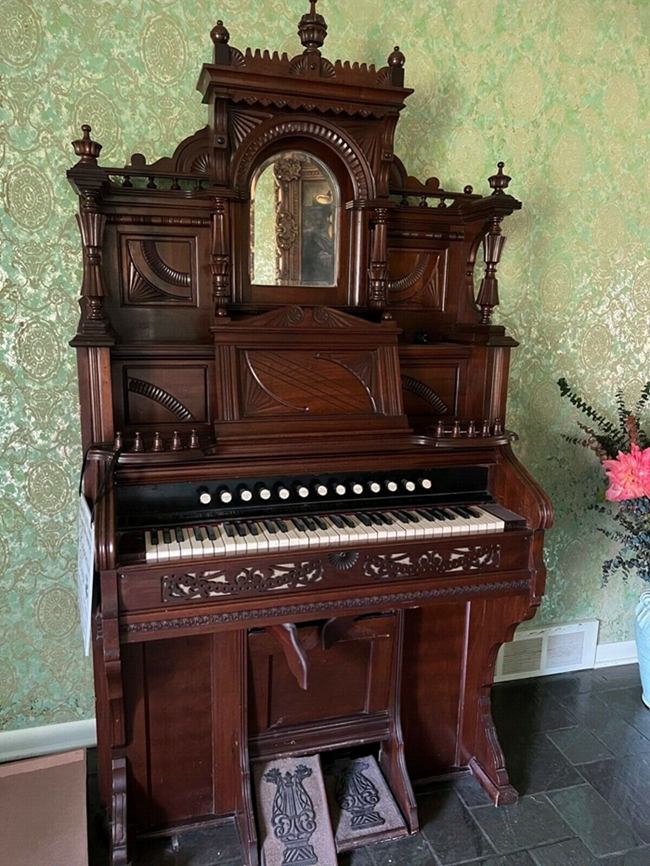
1. Antique Victorian Collins & Armstrong Pump Parlor Organ Intricate Ornate
It is an Armstrong unit that consists of a Walnut wooden build with several intricate floral and geometric patterns (also present on the foot pedals). The clues on the pump organ unit say it is from 1896. The team is running fine with the keys, pump, and knobs or stop levers.
Price$(1170)
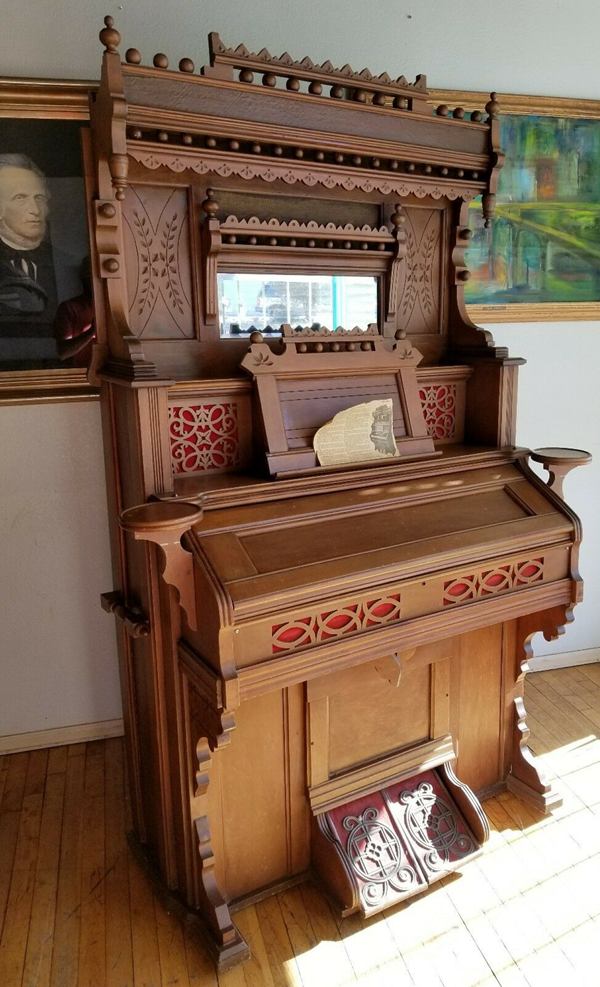
How To Get Rid Of Pump Organ
Here are ways to get rid of your pump organ if you no longer wish to sell or you’re feeling charitable:
Sell It
If your antique pump organ happens to have a meager price tag, you can simply sell it at your local pawn store.
Donate
Sometimes you might not have much luck selling your pump organ, which can be frustrating. However, instead of dumping it in the trash or abandoning it in your garage to house pests and rodents, you can simply donate it because many organizations see the antique Pump Organ as valuable. Such as the local church or school (for their music department).
Note: it would be great to restore the pump organ if the piece happens to be damaged.
Disassemble
An alternative action is to disassemble the pump organ and use its part carefully. For instance, you can take out the cabinet section and convert it into a box or a wall cabinet. You could also take out various mechanical parts of the Organ and then sell them on eBay or Esty to collectors that need specific details to complete the full restoration of your pump organs.
Where to Buy Antique Pump Organs
Antique Pump organs are available in online stores such as eBay, Etsy, 1stdibs, and amazon. But buying from such sites could be a wrong decision as there’s still a chance the Organ you ordered might have some damage. All because you weren’t able to examine the product before buying. It is why it’s far better to buy at auction, your local antique store, thrift shop, garage sale, or even estate sales.
Additional Online Resources
You can get more information about your antique Pump Organ via the blog post section of various appraisal websites, especially those dealing with Pump organs alone. The blog posts could contain several methods you can use to identify your antique Pump Organ and strategies that can help assess its value. If you’re not satisfied with your find, you can visit forums that give you access to other collectors and appraisal people.
It would be ideal to find an expert in selling and buying antiques at your local antique store for advice on your piece. They might not offer much, but you could be right.
List of forums to check out:
Final Words
You should be able to take on the antique market for Pump organs from the information we’ve set out. You can now identify your pump Organbased on the date of manufacture, its manufacturer, and material of the pump organ. We’ve also given you foolproof methods for effectively Assessing its value to confidently negotiate its price with another collector with a higher chance of success.
You should also restore your antique Pump Organ with the steps above. And we’ve also offered advice on how to get rid of the Organ if there happens to be no chance of selling it.





![Where To Sell Antique Furniture In 2022 [Ultimate Guide]](https://www.jacquelinestallone.com/wp-content/uploads/2022/09/Etsy-Your-Place-To-Buy-And-Sell-All-Things-Handmade-600x450.jpg)


